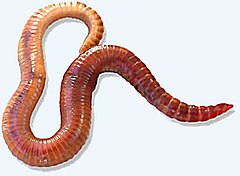Redworm
| Eisenia fetida | |
|---|---|
 |
|
| Scientific classification | |
| Kingdom: | Animalia |
| Phylum: | Annelida |
| Class: | Clitellata |
| Order: | Haplotaxida |
| Family: | Lumbricidae |
| Genus: | Eisenia |
| Species: | E. fetida |
| Binomial name | |
|
Eisenia fetida (Savigny, 1826) |
|
Eisenia fetida (older spelling: foetida), known under various common names such as redworm, brandling worm, panfish worm, trout worm, tiger worm, red wiggler worm, red californian earth worm, etc., is a species of earthworm adapted to decaying organic material. These worms thrive in rotting vegetation, compost, and manure. They are epigean, rarely found in soil. In this trait they resemble Lumbricus rubellus.
They have groups of bristles (called setae) on each segment that move in and out to grip nearby surfaces as the worms stretch and contract their muscles to push themselves forward or backward.
Eisenia fetida worms are used for vermicomposting of both domestic and industrial organic waste. They are native to Europe, but have been introduced (both intentionally and unintentionally) to every other continent except Antarctica.
When roughly handled, an Eisenia fetida exudes a pungent liquid, thus the specific name foetida meaning . This is presumably an antipredator adaptation.
Eisenia fetida is closely related to Eisenia andrei, also referred to as E. foetida andrei. The only simple way of distinguishing the two species is that E. foetida is sometimes lighter in colour. Molecular analyses have confirmed their identity as separate species and breeding experiments have shown that they do not produce hybrids.
As with other earthworm species, Eisenia fetida is hermaphroditic. However, two worms are still required for reproduction. The two worms join clitella, the large lighter-colored bands which contain the worms' reproductive organs, and which are only prominent during the reproduction process. The two worms exchange sperm. Both worms then secrete cocoons which contain several eggs each. These cocoons are lemon-shaped and are pale yellow at first, becoming more brownish as the worms inside become mature. These cocoons are clearly visible to the naked eye.
...
Wikipedia
